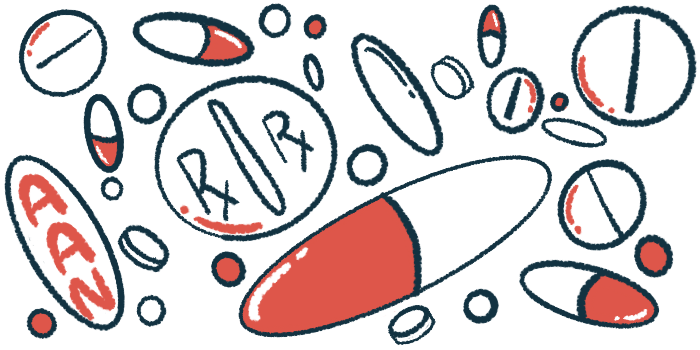AAN 2023: Rozanolixizumab yields benefits across gMG patient groups
Analyses of trial data of experimental therapy shared at AAN meeting

People with generalized myasthenia gravis (gMG) treated with the experimental therapy rozanolixizumab in a clinical trial generally experienced reductions in disease severity scores regardless of disease duration, prior treatments, and initial disease severity, new analyses suggest.
Findings were presented by Tuan Vu, MD, of the University of South Florida Morsani College of Medicine, at the American Academy of Neurology (AAN) 2023 Annual Meeting, held April 22-27 in Boston and virtually.
The presentation was titled, “Efficacy of Rozanolixizumab in Generalized Myasthenia Gravis: Subgroup Analyses from the Randomized Phase 3 MycarinG Study.” The work was funded by rozanolixizumab’s developer, UCB.
In MG, antibodies made by the immune system disrupt the communication between nerve and muscle cells, resulting in muscle weakness, fatigue, and other disease symptoms.
Rozanolixizumab is designed to lower the levels of disease-driving antibodies by binding to the neonatal Fc receptor (FcRn), a protein that normally prevents antibodies circulating in the bloodstream from being destroyed. By binding to FcRn, rozanolixizumab effectively prevents MG-driving antibodies from interacting with the protein, accelerating the pace at which they are destroyed.
The safety and efficacy of the investigational therapy have been evaluated in a Phase 3 trial MycarinG (NCT03971422), which enrolled 200 adults with gMG. All were positive for antibodies against the acetylcholine receptor (AChR) or muscle-specific kinase (MuSK) — the most common types of MG-driving antibodies.
Participants were assigned randomly to receive rozanolixizumab, at doses of 7 or 10 mg/kg, or a placebo, given via subcutaneous (under-the-skin) infusion once per week, for six weeks. After the six-week study, patients entered an eight-week observation period.
Results from the trial showed that, in the overall group, rozanolixizumab led to significant improvements in the scores of the MG Activities of Daily Living (MG-ADL), a patient-reported measure of disease severity. Comparing day 43 (week 6) to the start of the trial, MG-ADL scores improved by a mean of 3.4 points for patients on either dose of rozanolixizumab, compared with less than one point for those on placebo.
A recent subgroup analysis showed that similar improvements were seen in the subset of patients with antibodies against MuSK.
Subgroup analyses
In the presentation at the AAN meeting, Vu presented data from additional subgroup analyses of the trial. One analysis compared the outcomes of patients who previously had been on two or more MG therapies, to those who previously had fewer lines of treatment. Another analysis split patients into two groups, based on whether they had been living with MG for less than four years, or four years or more. A third analysis compared the outcomes of patients with an initial score of 15 points or less on the Quantitative MG (QMG) scale, to those of patients who had higher scores on this clinician-rated measure of disease severity.
Across all these analyses, results showed that treatment with rozanolixizumab had a consistent effect. In all subgroups, MG-ADL scores improved by a mean of about three to four points after six weeks of treatment with either dose of the therapy, while participants given a placebo saw their scores improve by one point or less.
“The results indicate that rozanolixizumab could provide therapeutic benefit across a broad range of patients with gMG,” Vu said.
Safety data from MycarinG suggested rozanolixizumab was generally tolerated well, with most side effects rated as being mild or moderate in severity. Commonly reported side effects included fever, headache, nausea, and diarrhea.
After completing MycarinG, participants had the option to enroll into one of two extension studies. In one, called MG0007 (NCT04650854), participants are being given additional six-week cycles of weekly rozanolixizumab, with the timing of treatment cycles being tailored based on patient symptoms.
In the other, MG0004 (NCT04124965), participants are given weekly injections with rozanolixizumab for up to about a year. Patients who complete at least six treatment visits in MG0004 then may move on to MG0007.
More rozanolixizumab updates
In a separate poster presented at the AAN meeting, researchers shared data from a pooled analysis that included findings from MycarinG, interim data from MG0007, and data from the first six weeks of MG0004. The goal was to assess the effect of a six-week cycle of rozanolixizumab and to see whether the effect was consistent with additional treatment cycles.
The poster was titled, “Long-term Efficacy and Safety of Symptom-driven Cyclic Rozanolixizumab Treatment in Patients with Generalized Myasthenia Gravis: A Pooled Analysis of a Phase 3 Study and Two Open-label Extension Studies.”
Results suggested that six weeks of treatment with rozanolixizumab led to a roughly four-point mean improvement in MG-ADL scores, with similar effects seen on the first through the sixth cycle of treatment. Analyses of scores on the QMG, and another measure of disease severity called MG Composite, or MGC, also showed a consistent beneficial effect of treatment across cycles.
“Rozanolixizumab efficacy was maintained in multiple MG-specific outcomes with improvements consistent across repeated cycles of treatment,” the researchers wrote.
Safety data also were consistent across subsequent cycles of treatment, with no apparent increase in the rates of safety-related events with additional treatment cycles. Researchers noted that the overall rate of safety-related findings was somewhat higher in patients who were on the higher dose of rozanolixizumab (91.6% vs. 77.4%).
Analyses also suggested that, following any given treatment cycle, more than half of the patients had treatment-free gaps of about one to three months before starting the next cycle.
“This pooled analysis supports the efficacy and safety of repeated cycles of rozanolixizumab for the treatment of gMG,” the researchers wrote.
Note: The Myasthenia Gravis News team is providing coverage of the American Academy of Neurology (AAN) 2023 Annual Meeting April 22-27. Go here to see the latest stories from the conference.







